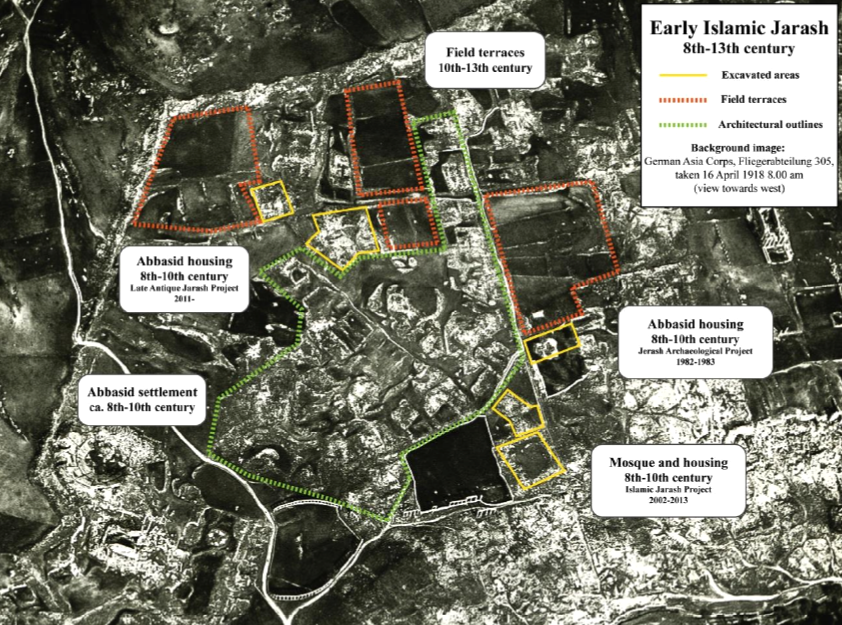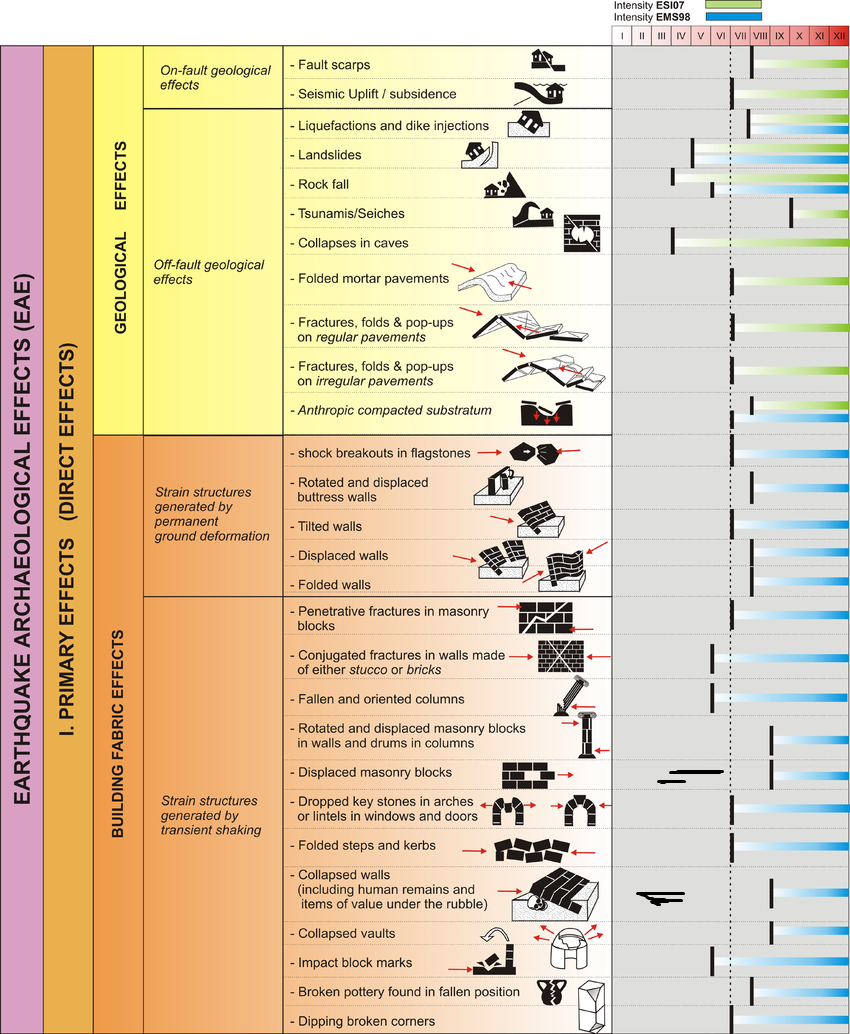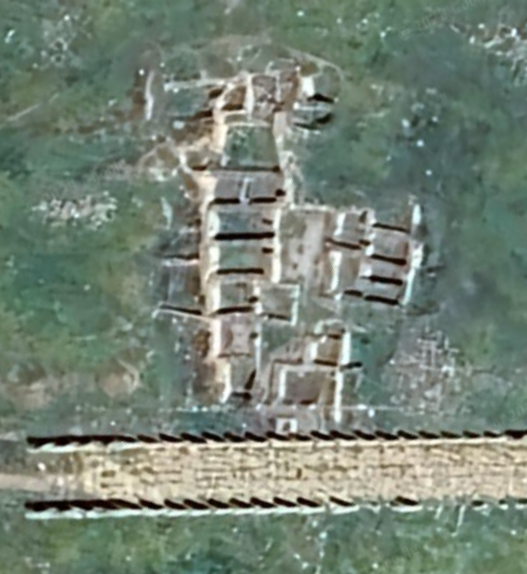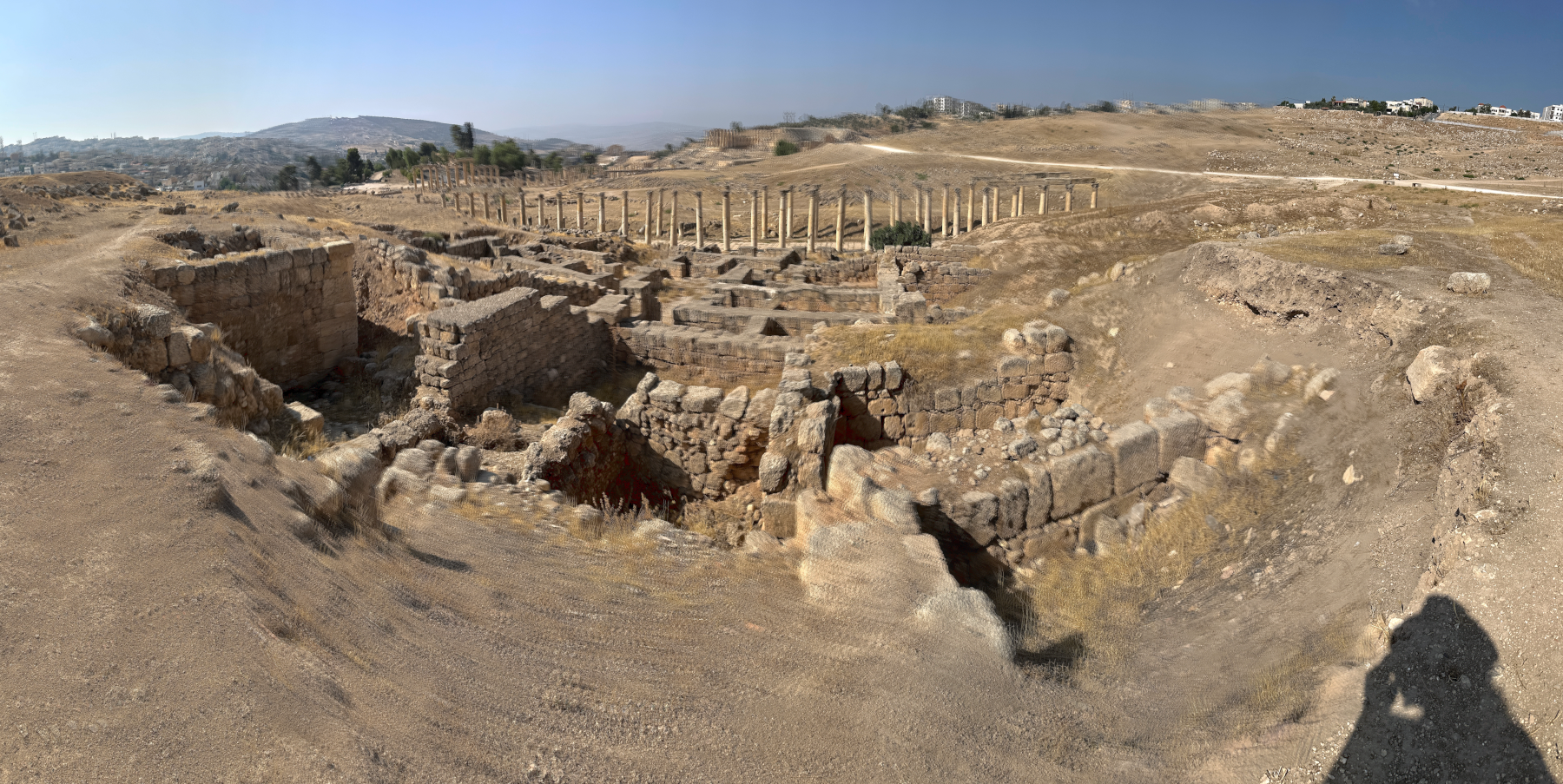Jerash - Umayyad House
- from Chat GPT 4o, 22 June 2025
- source: Gawlikowski (1992)
- from Jerash - Introduction - click link to open new tab
- General Plan of Jerash
from Wikipedia
- Fig. 2 - Plan of Umayyad
Jerash from Walmsley and Daamgaard (2005)


Figure 2
Plan summarising the principal urban features of Umayyad Jarash.
- Umayyad mosque
- possible Islamic administrative centre
- market (suq)
- South Tetrakonia piazza (built over)
- Macellum, with Umayyad–Abbasid rebuilding, and south cardo, encroached by structures;
- Oval piazza domestic quarter with fountain;
- Zeus temple forecourt (kiln, monastery?)
- hippodrome and Bishop Marianos church, eighth century use
- church of SS Peter and Paul and Mortuary Church (Umayyad construction date?)
- churches of SS Cosmas and Damianus, St George and St John theBaptist, with Umayyad–Abbasid occupation and iconoclastic-effected mosaics (later eighth century)
- Christian complex of two churches (Cathedral to the east with stairs from the street, St Theodore’s to the west), mid-5th to late 6th century Bath of Placcus (north of St Theodore’s) and houses west of St Theodore’s with extensive Umayyad occupation including a kiln and oil press
- Artemis compound used for ceramic manufacture
- Synagogue church with iconoclastic-effected mosaics
- North Theatre, also industrialised with kilns
- the 1981 ‘mosque’
- central Cardo with blacksmith’s shop and offices
Map modfied from R.E. Pillen in Zayadine (1986).
Walmsley and Daamgaard (2005) - Fig. 13 - Early Islamic
Jerash - 8th to 13th century CE - from Rattenborg and Blanke (2017)

 Figure 13
Figure 13
Early Islamic Jerash
8th to 13th century CE
Rattenborg and Blanke (2017)
- Fig. 2 - Plan of Umayyad
Jerash from Walmsley and Daamgaard (2005)


Figure 2
Plan summarising the principal urban features of Umayyad Jarash.
- Umayyad mosque
- possible Islamic administrative centre
- market (suq)
- South Tetrakonia piazza (built over)
- Macellum, with Umayyad–Abbasid rebuilding, and south cardo, encroached by structures;
- Oval piazza domestic quarter with fountain;
- Zeus temple forecourt (kiln, monastery?)
- hippodrome and Bishop Marianos church, eighth century use
- church of SS Peter and Paul and Mortuary Church (Umayyad construction date?)
- churches of SS Cosmas and Damianus, St George and St John theBaptist, with Umayyad–Abbasid occupation and iconoclastic-effected mosaics (later eighth century)
- Christian complex of two churches (Cathedral to the east with stairs from the street, St Theodore’s to the west), mid-5th to late 6th century Bath of Placcus (north of St Theodore’s) and houses west of St Theodore’s with extensive Umayyad occupation including a kiln and oil press
- Artemis compound used for ceramic manufacture
- Synagogue church with iconoclastic-effected mosaics
- North Theatre, also industrialised with kilns
- the 1981 ‘mosque’
- central Cardo with blacksmith’s shop and offices
Map modfied from R.E. Pillen in Zayadine (1986).
Walmsley and Daamgaard (2005) - Fig. 13 - Early Islamic
Jerash - 8th to 13th century CE - from Rattenborg and Blanke (2017)

 Figure 13
Figure 13
Early Islamic Jerash
8th to 13th century CE
Rattenborg and Blanke (2017)
- Early Islamic Jerash from
Rattenborg and Blanke (2017)

 Early Islamic Jerash
Early Islamic Jerash
Rattenborg and Blanke (2017)
- Early Islamic Jerash from
Rattenborg and Blanke (2017)

 Early Islamic Jerash
Early Islamic Jerash
Rattenborg and Blanke (2017)
- Fig. 1 - Plan of the
Umayyad House from Gawlikowski (1992)

 Fig. 1
Fig. 1
Plan of the Umayyad House (7th century CE). from A. Ostrasz.
Gawlikowski (1992)
- Fig. 1 - Plan of the
Umayyad House from Gawlikowski (1992)

 Fig. 1
Fig. 1
Plan of the Umayyad House (7th century CE). from A. Ostrasz.
Gawlikowski (1992)
- Panorama of Ummayad House - photo by JW
- Re-used building elements
in the Ummayad House - photo by JW

 Re-used building elements in the Ummayad House at Jerash
Re-used building elements in the Ummayad House at Jerash
JW: This wall shows signs of recent reconstruction however the reconstruction may have preserved the re-used building elements present in the original wall
Click on image to open a high resolution magnifiable image in a new tab
Photo by Jefferson Williams - 23 June 2025
- Panorama of Ummayad House - photo by JW
- Re-used building elements
in the Ummayad House - photo by JW

 Re-used building elements in the Ummayad House at Jerash
Re-used building elements in the Ummayad House at Jerash
JW: This wall shows signs of recent reconstruction however the reconstruction may have preserved the re-used building elements present in the original wall
Click on image to open a high resolution magnifiable image in a new tab
Photo by Jefferson Williams - 23 June 2025
- General Plan of Jerash
from Wikipedia
- Early Islamic Jerash from
Rattenborg and Blanke (2017)

 Early Islamic Jerash
Early Islamic Jerash
Rattenborg and Blanke (2017) - Fig. 1 - Plan of the Umayyad House
from Gawlikowski (1992)

 Fig. 1
Fig. 1
Plan of the Umayyad House (7th century CE). from A. Ostrasz.
Gawlikowski (1992)
Gawlikowski (1992:358) reports that the Umayyad house was
built on level ground after an earthquake
. They discuss its date of construction below:
The construction is well dated by the numismatic findings: on one hand coins of Constantius II (641-668), the last Byzantine coins having been used in Syria-Palestine, found within the fill (at depth and on the surface), and on the other hand Arab-Byzantine coins minted at Scythopolis (Beisan) and Jerash itself, "sealed" under the ground of the House. The exact dating of the latter coinage is not assured, but it is reasonable to place it around the middle of the 7th century, if not later (Bates, 1976). Therefore, I propose that the the earthquake that preceded construction as the one that struck Syria-Palestine in June 658, according to the testimony of Theophanes (Grumel 1958:479; Kallner-Amiran 1950-51:226). A recent discovery by J. Seigne corroborates our identification: the collapse of the vaulted corridor of the lower terrace of Zeus buries under the rubble a herd of goats; the age of a kid indicates that the cataclysm took place in May-June and moreover a Byzantine currency with an Arab countermark indicating the beginning of Muslim government (Seigne, unpublished report of 1984, kindly communicated by the author).The archaeoseismic evidence is based on rebuilding evidence. No seismic effects from a 7th century CE earthquake are mentioned.
- from Chat GPT 4o, 22 June 2025
- from Gawlikowski (1992)
built on level ground after an earthquake. It was bordered on both sides by high fill deposits, interpreted as clearance layers from this seismic destruction.
The event is dated through numismatic evidence: coins of Constans II (r. 641–668) were found within the underlying fill, while Arab-Byzantine coins from Scythopolis and Jerash were sealed beneath the house’s floors. The author proposes a terminus post quem in the mid-7th century, suggesting the structure was built after the June 658 earthquake [JW: slightly incorrect date for 659/660 CE Jordan Valley Quake(s)], described by Theophanes.
Additional supporting evidence comes from Jacques Seigne, who reported that a vaulted corridor on the lower terrace of the Zeus sanctuary collapsed, burying a herd of goats. The age of a kid and a coin with an Arab countermark place the event in May–June, shortly after the Muslim conquest.
No direct seismic damage (e.g., tilted walls, collapsed vaults, faults) from the 7th century was reported in the house itself. Instead, the archaeoseismic signal is inferred from stratigraphic evidence and intentional rebuilding.
- General Plan of Jerash
from Wikipedia
- Early Islamic Jerash from
Rattenborg and Blanke (2017)

 Early Islamic Jerash
Early Islamic Jerash
Rattenborg and Blanke (2017) - Fig. 1 - Plan of the Umayyad House
from Gawlikowski (1992)

 Fig. 1
Fig. 1
Plan of the Umayyad House (7th century CE). from A. Ostrasz.
Gawlikowski (1992)
- from Chat GPT 4o, 22 June 2025
- from Gawlikowski (1992)
According to Gawlikowski (1992:358), the house’s interior was reoccupied and repurposed during the Abbasid period. Rooms were subdivided, new installations were added, and signs of domestic activity continued. The modifications were interpreted as signs of impoverishment rather than destruction and rebuilding.
The absence of a collapse layer or widespread clearing of debris suggests that this particular structure may have escaped major damage during the 749 CE earthquake. As such, the archaeoseismic evidence from this location is negative or absent for the 8th century.
| Century (AD) | Event (AD) attribution by original author |
Reliability of interpreted evidence |
Likely attributable seismic event (AD) |
Locality | Plan ref. | Reference |
|---|---|---|---|---|---|---|
| 9th | Post-770 | High | 854 | Umayyad House, South Decumanus | 7 | Gawlikowski 1986, 113. |
| Effect | Location | Image(s) | Description |
|---|---|---|---|
|
Umayyad House |
|
| Effect | Location | Image(s) | Description |
|---|---|---|---|
|
Umayyad House |
|
-
Earthquake Archeological Effects chart
of Rodríguez-Pascua et al (2013: 221-224)

 Earthquake Archeological Effects (EAE)
Earthquake Archeological Effects (EAE)
Rodríguez-Pascua et al (2013: 221-224)
| Effect | Location | Image(s) | Description | Intensity |
|---|---|---|---|---|
|
Umayyad House |
|
|
- Earthquake Archeological Effects chart
of Rodríguez-Pascua et al (2013: 221-224)

 Earthquake Archeological Effects (EAE)
Earthquake Archeological Effects (EAE)
Rodríguez-Pascua et al (2013: 221-224)
| Effect | Location | Image(s) | Description | Intensity |
|---|---|---|---|---|
|
Umayyad House |
|
|
Bates, M. L. (1976). "The 'Arab-Byzantine' Bronze Coinage of Syria:
An Innovation by 'Abd al-Malik," in A Colloquium in Memory of George
Carpenter Miles (1904–1975), New York: American Numismatic Society,
16–27.
Gawlikowski, 1992,
Installations Omayyades à Jérash, Studies in the History and Archaeology of Jordan 04
Lichtenberger, A. and Raja, R. (ed.s) (2025) Jerash, the Decapolis, and the Earthquake of AD 749 The Fallout of a Disaster
Belgium: Brepols.


